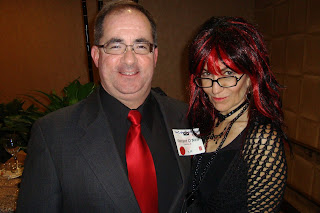 ROSEMARY HARRIS: This summer mystery lovers in the
tri-state area welcome the return of the Deadly Ink Mystery Conference. And the
guest of honor is none other than our own Hank Phillippi Ryan!
ROSEMARY HARRIS: This summer mystery lovers in the
tri-state area welcome the return of the Deadly Ink Mystery Conference. And the
guest of honor is none other than our own Hank Phillippi Ryan!
For the three people on the planet who don't know Hank -
and just to remind the rest of us of her rather amazing c.v., Hank is the
author of the Charlotte McNally mystery series—Prime Time, Face Time, Air Time
and Drive Time. She's been nominated for or won just about every major award in
the mystery community - Anthony,
Macavity, Agatha, Mary Higgins Clark - and she's just been nominated for a
Shamus Award for her most recent novel, The Other Woman (which a little bird
tells me is coming out in paperback next week).
And - oh yeah - she has a full-time job and a wall full of Emmys! With any luck, she'll tell us about her brand new book, The Wrong Girl. Which - ahem - is available for pre-order on Amazon right now http://www.amazon.com/Wrong-Girl-Hank-Phillippi-Ryan/dp/0765332582
The big fun for me is that I will be Toastmaster - so
I'll get to make jokes and heckle while Hank does all the heavy lifting.And - oh yeah - she has a full-time job and a wall full of Emmys! With any luck, she'll tell us about her brand new book, The Wrong Girl. Which - ahem - is available for pre-order on Amazon right now http://www.amazon.com/Wrong-Girl-Hank-Phillippi-Ryan/dp/0765332582
 This year’s conference kicks off with a full day of
Deadly Ink Writer’s Academy classes for aspiring writers, on Friday, Aug. 2.
Hank will present Writing Your Mystery—All You Need to Know Before You Start. I
will teach Characters and Setting, followed by Jane Cleland with Red Herrings.
Classes wind up with The Top 10 Reasons Your Novel is Rejected, by author and
agent Lois Winston. Official registration for the conference takes place Friday night 6-7 p.m., followed by a welcoming program and
a Deadly Dessert Party.
This year’s conference kicks off with a full day of
Deadly Ink Writer’s Academy classes for aspiring writers, on Friday, Aug. 2.
Hank will present Writing Your Mystery—All You Need to Know Before You Start. I
will teach Characters and Setting, followed by Jane Cleland with Red Herrings.
Classes wind up with The Top 10 Reasons Your Novel is Rejected, by author and
agent Lois Winston. Official registration for the conference takes place Friday night 6-7 p.m., followed by a welcoming program and
a Deadly Dessert Party.
Both Saturday and Sunday feature and presentations by 30
authors and other mystery and crime experts including good pals Donald and Renee Bain, authors of - among many books - the Murder She Wrote series.
At lunch on Saturday, I'll interview (heckle) Hank about her career and other notable authors on hand will briefly discuss their latest books. Saturday night features a Gala Awards Dinner with a keynote address by Hank. Signings will be held throughout the weekend. Bob Daniher is the Offical Fan Guest of Honor.
At lunch on Saturday, I'll interview (heckle) Hank about her career and other notable authors on hand will briefly discuss their latest books. Saturday night features a Gala Awards Dinner with a keynote address by Hank. Signings will be held throughout the weekend. Bob Daniher is the Offical Fan Guest of Honor.
When and where? - August
2-4 at the Hyatt Regency, 2 Albany St., New Brunswick, NJ. New Brunswick is just a short train ride from
Manhattan - good news for those of us who might not want to drive.
More information and a registration form can be found at
the web site, www.deadlyink.org. Hope to see some of you there!












































